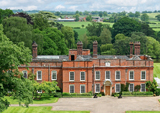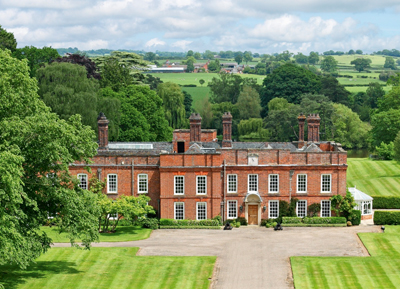An historic estate in Shropshire
A Shropshire estate with 681 acres has come onto the market at a guide of £12m, as has 'one of the finest houses for sale in Hampshire in five years'


This week's Country Life sees the launch onto the market, through Savills (01952 239500), of the historic, 681-acre Peplow estate at Hodnet, near Market Drayton, Shropshire, at a guide price of excess £12 million for the whole. The price ticket on the main house-the exquisite, early-Georgian Peplow Hall, listed Grade II*-is £5 million with its immediate 100 acres of landscaped gardens and parkland. Shropshire is known for being a quiet county, but Peplow's history has sometimes been anything but tranquil. Listed as Papelau in Domesday, the estate was held by Ralph de Mortimer after the Conquest, but was forfeited when he took part in a rebellion against William I.
In the 13th century, the estate was part of the Hodnet estate, after which it passed to the de Ludlows and the Vernons. Peplow remained in Vernon family hands until 1715, when Sir Richard Vernon sold it to Hugh Pigot from Cheshire for £5,000. A later Hugh Pigot built the present Peplow Hall in 1725. In about 1800, the Pigots sold Peplow to Thomas Clarke of Liverpool for £45,000 and, on Clarke's death, it was bought by Arthur Clegg of Manchester for £60,000. In 1831, Clegg's granddaughter, Anne, heiress to the estate, married Rowland (later Viscount) Hill of nearby Hawkstone Hall, a member of a notoriously extravagant family, which eventually ran out of money. In 1873, Francis Stanier, a wealthy industrialist, bought the Peplow estate and, in 1877, considerably enlarged the 1725 house.

Peplow Hall, Shropshire, £12m, Savills
At that time, the estate totaled 4,000 acres, but the agricultural depression of the 1880s had already begun to bite when, on Stanier's death in 1900, the estate passed to his son, Beville, later 1st Baronet Stanier. It's a measure of the bond forged between traditional Shropshire landowners and their tenants, that, in December 1920, following the devastation of the First World War, Peplow's tenants pleaded with Sir Beville not to sell the estate.
Although concerned for their plight, Stanier felt he had no choice but to move to a smaller, more manageable house, but Peplow Hall was still in the family when he died in 1921. A year later, the house and its remaining 1,000 acres were back on the market and, by the early 1930s, the hall had also been substantially reduced in size.
In the 1950s, Capt Bill Higgin was the squire of Peplow Hall. One of the finest game shots of his generation, he managed to shoot five days a week and, when a friend remarked that he had spent a fortune shooting, Higgin is reputed to have said: ‘No, I have spent three.' Fortunately for the survival of Peplow Hall and its estate, its current owner, Robert Vaughan Wynn, 8th Baron Newborough, has a more practical attitude to life.
One of three family estates owned and run by Lord Newborough- the other two being the 12,500-acre Rhug estate in Denbighshire and the Glynllifon estate in Gwynedd-Peplow has been his family home for the past 30 years and its impeccably managed farmland is an intrinsic part of the fast-growing, 7,000-acre Rhug Organic Farm business that, last year, earned him the title of Farmers Weekly Diversification Farmer of the Year.
Exquisite houses, the beauty of Nature, and how to get the most from your life, straight to your inbox.

Shaking off the jetlag from a recent trip to the Far East, where he regularly promotes sales of the farms' wide range of organic produce-from beef, wild bison and lamb to chicken, pork and organic fodder-Lord Newborough sets off on a tour of the hall and its grounds, where efficiency and ease of maintenance are clear guiding principles. ‘We have one man who mows four days a week and a plantsman for two days a week-that's it,' Lord Newborough explains. Smooth green lawns surround the house and lead down to the seven-acre lake. In the formal garden areas, fussy herbaceous borders have been replaced by walks and arbours of wisteria and hydrangeas as well as banks of azaleas or rhododendrons.
A wonderful curved-walled kitchen garden-one of few in the country-encloses neat asparagus beds and pleached fruit trees. Beyond the formal gardens, an arboretum of specimen trees includes wellingtonias, yews, oaks and ashes. Around the perimeter of the main house, neat clusters of estate buildings include 10 let houses and cottages. Barely visible from the world outside is Peplow Hall itself, a gem of elegant Georgian architecture, with light, panelled reception rooms and bedrooms and beautifully carved fireplaces in all the main reception rooms.
An impressive mid-18th-century staircase links the entrance and reception halls with the eight first-floor bedrooms and bathrooms. And, in another stroke of planning genius, the informal part of the house, comprising the master suite (including Lord Newborough's private gym) and the main family kitchen and sitting room can be shut off from the rest of the house behind adjoining doors, should the owners find themselves at home alone.

Cheriton House, Hampshire, £5.5m, Knight Frank
Hungerford-based Nick Ashe, of buying agents Property Vision, is excited at the thought of seeing inside ‘one of the finest houses to come to the market in Hampshire in the past five years', having only ever managed to catch ‘the merest glimpse' of secluded Cheriton House at Cheriton, near Alresford, on his many frequent forays around the county's lanes. For sale through Knight Frank in Winchester (01962 850333) and ‘conservatively priced', in Mr Ashe's view, at £5.5 million, the handsome, Grade II-listed Georgian house, built around an earlier farmhouse in the late 1700s, ‘is bound to cause a stir, especially among buyers in Kensington and Chelsea, who may be thinking of cashing in on property gains achieved in London in recent years'.
For the past 45 years, Cheriton House-which stands bang in the middle of its 20 lush acres of gardens, parkland and pasture-has been the cherished family home of international businessman Robin Fox and his wife, Lindsay, a former High Sheriff and deputy lieutenant of the county, who was awarded an MBE in last year's Birthday Honours List, for a lifetime of tireless charity work. ‘The house hasn't changed much since we bought it, and not much before that either, as the previous owner- a widow when she sold Cheriton House-had also lived there for the best part of 50 years,' Mrs Fox explains.
In the late 18th century, Cheriton House, then known as Cheriton Lodge, was owned by John Smythe, the brother of the celebrated Mrs Fitzherbert, a virtuous Catholic beauty who was pursued by the then Prince of Wales, later George IV, but refused to become his mistress. In 1785, the Prince defied his father's wishes and married Mrs Fitzherbert, who was twice a widow and six years older than he. But, as she was a Catholic, the union wasn't recognised under the Royal Marriages Act 1772. His later marriage to Caroline of Brunswick was not a happy one and George IV is said to have died with a miniature of Mrs Fitzherbert hanging around his neck.
Mr and Mrs Fox will be sad to leave Cheriton House, where they have reared their four children and welcomed frequent visits from their 11 grandchildren. But they won't be moving far, having already found a smaller house in this pretty thatched conservation village within the South Downs National Park. Cheriton House, which ‘is not a huge house and easy to run'-with 8500sq ft of accommodation, including entrance and reception halls, three main reception rooms, a piano room, a conservatory, a kitchen/breakfast room, master and two guest suites, four further bedrooms and two family bathrooms-is ready to welcome the next generation to ‘one of the best bits of Hampshire'.
* Follow Country Life magazine on Twitter
Country Life is unlike any other magazine: the only glossy weekly on the newsstand and the only magazine that has been guest-edited by His Majesty The King not once, but twice. It is a celebration of modern rural life and all its diverse joys and pleasures — that was first published in Queen Victoria's Diamond Jubilee year. Our eclectic mixture of witty and informative content — from the most up-to-date property news and commentary and a coveted glimpse inside some of the UK's best houses and gardens, to gardening, the arts and interior design, written by experts in their field — still cannot be found in print or online, anywhere else.

